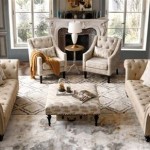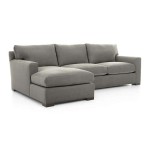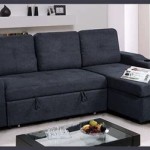How To Style a Sofa With Cushions
The sofa, often the centerpiece of a living space, provides an opportunity to express personal style and enhance the overall aesthetic of a room. While the sofa itself establishes the foundation, the strategic application of cushions elevates its visual appeal and comfort. Styling a sofa with cushions is not merely about scattering pillows; it involves a thoughtful approach that considers color palettes, textures, sizes, patterns, and arrangements to achieve a cohesive and inviting design.
Effective cushion styling enhances comfort and functionality while contributing to the overall harmony of the room. A well-styled sofa can transform a simple seating area into a sophisticated and welcoming space that reflects the inhabitant's taste and personality.
Understanding the Fundamentals of Cushion Styling
Effective cushion styling relies on a comprehensive understanding of several key elements. These elements, when combined thoughtfully, create a visually appealing and comfortable arrangement.
Color Palette: The color palette forms the bedrock of any successful cushion arrangement. The chosen colors should harmonize with the existing decor of the room and the sofa itself. One approach is to select cushions in colors that complement the sofa's upholstery. For example, a neutral sofa can be paired with cushions in various shades of the same color family for a monochromatic look. Alternatively, a contrasting color scheme can add visual interest and energy to the space. Consider using the color wheel to identify complementary colors that work well together. Accenting with a pop of color from a nearby rug or piece of artwork can further enhance the cohesion of the room. It is essential to consider the overall mood you wish to create. Light and airy colors will create a more calm and serene environment, whereas bold and saturated colours will create a more vibrant and energetic space.
Texture: Texture adds depth and dimension to the sofa arrangement. Combining cushions with different textures, such as velvet, linen, cotton, or wool, creates a tactile experience that is both visually interesting and comfortable. Incorporating textured cushions can also soften the look of a sleek, modern sofa or add a touch of sophistication to a more casual setting. Consider the season when selecting textures; lighter fabrics like linen and cotton work well in the warmer months, while heavier fabrics like velvet and wool provide warmth and comfort in the colder months. Think about the contrast that different textures can provide. A sleek leather sofa can benefit from the added softness of a knitted or faux fur cushion.
Size and Shape: Varying the size and shape of cushions adds visual interest and prevents the arrangement from looking monotonous. A common approach is to use larger cushions as a base and layer smaller cushions in front. Standard square sizes range from 18x18 inches to 24x24 inches. Rectangular lumbar cushions can provide back support and add a different shape to the arrangement. Round or bolster cushions can also be incorporated to soften the hard lines of the sofa and add a touch of elegance. Ensure that the size of the cushions is proportionate to the size of the sofa. Overly large cushions can overwhelm a smaller sofa, while overly small cushions can get lost on a larger sofa. Experiment with different combinations of sizes and shapes to find an arrangement that is visually pleasing and comfortable.
Pattern: Introducing patterns through cushions can add personality and character to the sofa. When selecting patterned cushions, consider the existing patterns in the room, such as those found in the rug, curtains, or wallpaper. Avoid overwhelming the space with too many different patterns. A general rule of thumb is to mix a large-scale pattern with a smaller-scale pattern or a solid color. Geometric patterns, floral patterns, and abstract patterns can all be used effectively, depending on the overall style of the room. For a more cohesive look, repeat a color from the patterned cushions in other elements of the room. Consider the impact of different types of patterns. Geometric patterns tend to be more modern, while floral patterns tend to be more traditional. Stripes can add a sense of movement to the arrangement, while polka dots can add a touch of whimsy.
Arrangement: The arrangement of cushions on the sofa is just as important as the selection of the cushions themselves. A balanced arrangement is generally more visually appealing than a symmetrical one. Experiment with different arrangements to find one that is both aesthetically pleasing and comfortable. A common approach is to place the largest cushions at the corners of the sofa and layer smaller cushions in front, working inwards toward the center. You can also create a more asymmetrical arrangement by grouping cushions on one side of the sofa and leaving the other side relatively bare. Consider the purpose of the sofa when arranging cushions. If the sofa is primarily used for lounging, ensure that the cushions provide adequate support. If the sofa is primarily used for formal gatherings, a more decorative arrangement may be appropriate.
Practical Steps for Styling Your Sofa
After understanding the fundamental elements, the next step involves applying them practically to style your sofa. This section provides a step-by-step guide to help you create a visually appealing and comfortable cushion arrangement.
Assess Your Sofa and Room: Before selecting any cushions, take a close look at your sofa and the surrounding room. Consider the style of the sofa, the color of the upholstery, and the overall decor of the room. Identify the dominant colors, patterns, and textures already present in the space. This assessment will help you choose cushions that complement the existing elements and create a cohesive look. Note the size and shape of the sofa. A large sectional sofa can accommodate a more elaborate cushion arrangement than a smaller loveseat. Also, consider the purpose of the sofa. Is it primarily used for formal gatherings, casual lounging, or a combination of both? This will influence the type and arrangement of cushions you choose.
Choose a Color Palette: Based on your assessment of the sofa and room, select a color palette for your cushions. You can opt for a monochromatic scheme, a complementary color scheme, or a more eclectic mix of colors. Consider the mood you want to create. Light and airy colors can create a calming and relaxing atmosphere, while bold and vibrant colors can add energy and excitement to the space. If you are unsure where to start, consider pulling colors from existing artwork, rugs, or other decorative elements in the room. You can also use online color palette generators or consult with a design professional for guidance. Limit your color palette to a maximum of three to four colors to avoid overwhelming the space.
Select Cushions in Different Sizes and Shapes: Choose cushions in a variety of sizes and shapes to add visual interest and depth to the arrangement. Start with larger cushions for the back and layer smaller cushions in front. Consider incorporating rectangular lumbar cushions or round bolster cushions to break up the monotony of square cushions. A common approach is to use two larger square cushions (22x22 or 24x24 inches) at the corners of the sofa, followed by two slightly smaller square cushions (20x20 inches) in front, and then a lumbar cushion in the center. Experiment with different combinations of sizes and shapes to find an arrangement that is visually pleasing and comfortable.
Incorporate Different Textures: Add depth and dimension to the sofa arrangement by incorporating cushions with different textures. Consider using a combination of velvet, linen, cotton, wool, or faux fur. Textured cushions can soften the look of a sleek, modern sofa or add a touch of sophistication to a more casual setting. Consider the season when selecting textures. Lighter fabrics like linen and cotton work well in the warmer months, while heavier fabrics like velvet and wool provide warmth and comfort in the colder months. Layering textures can add visual interest and depth to the arrangement.
Introduce Patterns Strategically: Use patterns strategically to add personality and character to the sofa arrangement. When selecting patterned cushions, consider the existing patterns in the room. Avoid overwhelming the space with too many different patterns. A general rule of thumb is to mix a large-scale pattern with a smaller-scale pattern or a solid color. Geometric patterns, floral patterns, and abstract patterns can all be used effectively, depending on the overall style of the room. If you are unsure how to mix patterns, start with one patterned cushion and build around it with solid-colored cushions in complementary colors. Repeat a color from the patterned cushions in other elements of the room to create a cohesive look.
Arrange Cushions for Balance and Comfort: Experiment with different arrangements to find one that is both aesthetically pleasing and comfortable. A balanced arrangement is generally more visually appealing than a symmetrical one. Start by placing the largest cushions at the corners of the sofa and layer smaller cushions in front, working inwards toward the center. You can also create a more asymmetrical arrangement by grouping cushions on one side of the sofa and leaving the other side relatively bare. Consider the purpose of the sofa when arranging cushions. If the sofa is primarily used for lounging, ensure that the cushions provide adequate support. If the sofa is primarily used for formal gatherings, a more decorative arrangement may be appropriate. Regularly adjust the arrangement to maintain a fresh and inviting look.
Advanced Techniques for Cushion Styling
Beyond the basic principles, several advanced techniques can elevate your cushion styling skills and create a truly personalized and sophisticated look.
The Rule of Odds: The rule of odds suggests that arrangements with an odd number of items are generally more visually appealing than arrangements with an even number of items. Applying this rule to cushion styling involves arranging cushions in groups of three, five, or seven. For example, on a smaller sofa, you might arrange three cushions – one large cushion at the corner, a smaller cushion in front of it, and a lumbar cushion in the center. On a larger sofa, you could use five or seven cushions to create a more elaborate arrangement. The rule of odds helps to create a sense of asymmetry and visual interest, preventing the arrangement from looking too static or predictable.
Creating Visual Triangles: Visual triangles are a design technique that involves arranging elements in a way that creates an imaginary triangle. This technique can be used to create a sense of balance and harmony in the sofa arrangement. To create a visual triangle, consider the placement of colors, patterns, and textures. For example, you might place a patterned cushion at one corner of the sofa, a solid-colored cushion in a similar hue at the opposite corner, and a textured cushion in the center. The eye will naturally connect these three points, creating a visual triangle that is pleasing to the eye. Experiment with different combinations of colors, patterns, and textures to create different visual triangles and see what works best for your space.
Using Cushion Inserts Effectively: The quality and size of the cushion insert play a crucial role in the overall look and feel of the cushion. Overstuffed inserts can make cushions look bulky and uncomfortable, while understuffed inserts can make cushions look limp and lifeless. The ideal insert should fill the cushion cover completely, creating a firm and plump appearance. Feather or down inserts provide a luxurious and comfortable feel, but require regular fluffing to maintain their shape. Polyester inserts are more affordable and require less maintenance, but may not provide the same level of comfort. When selecting inserts, consider the size and shape of the cushion cover. The insert should be slightly larger than the cover to ensure a snug fit. For example, if you have an 18x18 inch cushion cover, use a 20x20 inch insert. Experiment with different types and sizes of inserts to find the perfect combination for your cushions.
Seasonal Updates: Updating your cushion arrangement seasonally can refresh your living space and reflect the changing seasons. In the spring and summer, opt for lighter fabrics like linen and cotton in bright and cheerful colors. Consider incorporating floral patterns or nautical stripes to bring a touch of the outdoors in. In the fall and winter, switch to heavier fabrics like velvet and wool in warm and cozy colors. Incorporate autumnal patterns like leaves or plaids to create a comforting and inviting atmosphere. Seasonal updates not only refresh the look of your sofa but also provide an opportunity to experiment with different color palettes, textures, and patterns.
By mastering these advanced techniques, one can transform a simple sofa into a stylish focal point of the room, reflecting individual taste and enhancing the overall ambiance.

Image Result For Cushion Arrangements On Sofa Cushions Arrangement Throw Pillows Living Room

How To Style Cushions On A Couch Better Homes And Gardens

An Expert S Guide How To Style Your Sofa Luxlife

How To Decorate With Ter Cushions Simply

6 Steps To Styling Cushions Like A Designer Lavender Hill Interiors

How To Style Throw Pillows On Your Couch Like A Designer Parachute Blog

How To Arrange Cushions On A Sofa Temple Webster

Take One Neutral Sofa How To Style Your Living Room 6 Diffe Ways My Thrifty Life By Cassie Fairy Inspiration For A Lovely On Budget

How To Dress A Sofa Style In Your Living Room

5 Ways To Choose Arrange Cushions On A Sofa Heal S Blog








